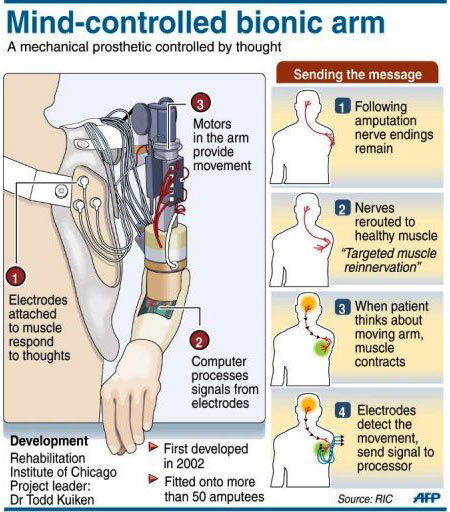Latest Research in Artificial / Prosthetic Limbs
Constant research in the field of bio engineering has given improved models of artificial limbs that very nearly replicate the functions of real, biological limbs. Phenomenal advances have been made in measurement techniques, materials science and manufacturing methods to render more realistic prosthetic limbs. Heavy, natural materials like wood, metal, alloy and leather are replaced by lighter, synthetic materials such as polyester resins, epoxy, high density poly ethylene (HDPE), high density polypropylene (HDPP) and other carbon fiber composites that render the artificial limbs lighter and more durable.
Two computerized control systems-myoelectric artificial limbs for upper limb amputees and cadence knee mechanism used in lower artificial limbs have afforded greater maneuverability for those who use artificial limbs. In the myoelectric prosthesis, when the amputee thinks and wants to open or close the fingers in his artificial hand, electrical signals produced at a neuro-muscular junction of the forearm are picked up by sensors inside the socket and activate a motor fixed in the wrist unit and make it move the fingers. It is also called the bionic prosthesis since it involves the amputee’s thought process.

The cadence control prosthesis involves a special knee unit that can be preset at different speeds and controlled through microchips. It vastly improves the gait of the amputee because the sensors in the artificial limb can judge the gait and speed of the normal limb and adjust the speed of the prosthetic knee accordingly.
Prosthetic experts are confident of huge improvements in the field to enable the user move more naturally with artificial limbs. Modern research is moving towards the ideal artificial limb that is lightweight, durable, easily adjustable, maintenance-free and looks almost real.
One latest development is a software that lays a grid on a CAT scan of the stump which gauges the exact pressure the soft tissue can hold with minimum pain. The prosthetist can design a socket that reduces the amount of soft tissue displaced by just looking at this computer model.
Research is also on to devise a pressure sensitive foot that could help amputees walk more naturally by enabling them feel the ground even with their artificial feet. Another new development in artificial legs is a built in computer in an above-knee unit that can be programmed to suit the person’s gait.
University of Michigan researchers from the departments of Biomedical and Mechanical Engineering have developed an energy-saving artificial foot which saves energy wasted in between steps and facilitates walking for amputees by recycling the saved energy.
 MEDINDIA
MEDINDIA
 Email
Email
I have lost my left leg in accident and its got amputed from knee. I am going to put artificial leg but I am confused wheter I can bend my leg from knee because I have got amputed from knee, I mean just exactly from knee
One of my brother lost his leg in an accident so he needs artificial limbs, I really found good information to help my brother...
Dear sir, This comment for my brother in law he lost his leg below the knee [ some portion is there in below knee ] in road accident recently. He is under treatment for fixing artificial leg, how long will take time and how much will be cost.
Dear sir i have lost my right hand in an accident. So i can replace it with artificial hand. D don't know about the whole process so can you suggest about all. Pls help me. As soon as possible....
Sir My son lost left hand from elbow in papad machine at 4 year old. Kindly give the new artificial working hand so he can do his work in both hand and drive vehicle.
Dear Mr. Sanjay,
We offer Complete Rehab facility associated with fitting and training of various Prosthesis including Myoelectric Upper limb Systems and Microprocessor controlled Lower Limb Systems.
Consult Orthopedic Doctor Online
Dr. Sachin Tutu
MBBS, MD, DNB
6 years experience
Dr. Deepak Nalla
MBBS, MS, Fellowship in Joint Replacement, Fellowship in Arthroscopy and Sports Medicine
9 years experience
Dr. Siddharth Jaiswal
MBBS, D ortho
6 years experience
Dr. Pankaj Kumar
MBBS, MS
18 years experience
Progressive Spine and orthopaedic , Near IGIMS, Patna
What's New on Medindia
Articles
Follow @MedIndia
Artificial Limbs - Related News